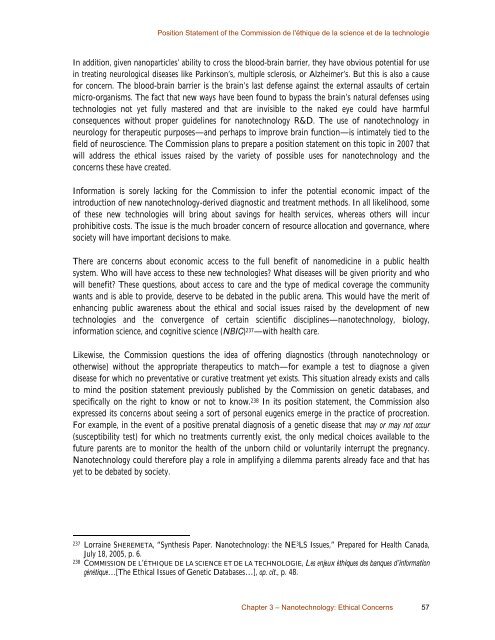A Basis for Action - Commission de l'éthique de la science et de la ...
A Basis for Action - Commission de l'éthique de la science et de la ...
A Basis for Action - Commission de l'éthique de la science et de la ...
You also want an ePaper? Increase the reach of your titles
YUMPU automatically turns print PDFs into web optimized ePapers that Google loves.
Position Statement of the <strong>Commission</strong> <strong>de</strong> l'éthique <strong>de</strong> <strong>la</strong> <strong>science</strong> <strong>et</strong> <strong>de</strong> <strong>la</strong> technologie<br />
In addition, given nanoparticles’ ability to cross the blood-brain barrier, they have obvious potential <strong>for</strong> use<br />
in treating neurological diseases like Parkinson’s, multiple sclerosis, or Alzheimer’s. But this is also a cause<br />
<strong>for</strong> concern. The blood-brain barrier is the brain’s <strong>la</strong>st <strong>de</strong>fense against the external assaults of certain<br />
micro-organisms. The fact that new ways have been found to bypass the brain’s natural <strong>de</strong>fenses using<br />
technologies not y<strong>et</strong> fully mastered and that are invisible to the naked eye could have harmful<br />
consequences without proper gui<strong>de</strong>lines <strong>for</strong> nanotechnology R&D. The use of nanotechnology in<br />
neurology <strong>for</strong> therapeutic purposes—and perhaps to improve brain function—is intimately tied to the<br />
field of neuro<strong>science</strong>. The <strong>Commission</strong> p<strong>la</strong>ns to prepare a position statement on this topic in 2007 that<br />
will address the <strong>et</strong>hical issues raised by the vari<strong>et</strong>y of possible uses <strong>for</strong> nanotechnology and the<br />
concerns these have created.<br />
In<strong>for</strong>mation is sorely <strong>la</strong>cking <strong>for</strong> the <strong>Commission</strong> to infer the potential economic impact of the<br />
introduction of new nanotechnology-<strong>de</strong>rived diagnostic and treatment m<strong>et</strong>hods. In all likelihood, some<br />
of these new technologies will bring about savings <strong>for</strong> health services, whereas others will incur<br />
prohibitive costs. The issue is the much broa<strong>de</strong>r concern of resource allocation and governance, where<br />
soci<strong>et</strong>y will have important <strong>de</strong>cisions to make.<br />
There are concerns about economic access to the full benefit of nanomedicine in a public health<br />
system. Who will have access to these new technologies? What diseases will be given priority and who<br />
will benefit? These questions, about access to care and the type of medical coverage the community<br />
wants and is able to provi<strong>de</strong>, <strong>de</strong>serve to be <strong>de</strong>bated in the public arena. This would have the merit of<br />
enhancing public awareness about the <strong>et</strong>hical and social issues raised by the <strong>de</strong>velopment of new<br />
technologies and the convergence of certain scientific disciplines—nanotechnology, biology,<br />
in<strong>for</strong>mation <strong>science</strong>, and cognitive <strong>science</strong> (NBIC) 237 —with health care.<br />
Likewise, the <strong>Commission</strong> questions the i<strong>de</strong>a of offering diagnostics (through nanotechnology or<br />
otherwise) without the appropriate therapeutics to match—<strong>for</strong> example a test to diagnose a given<br />
disease <strong>for</strong> which no preventative or curative treatment y<strong>et</strong> exists. This situation already exists and calls<br />
to mind the position statement previously published by the <strong>Commission</strong> on gen<strong>et</strong>ic databases, and<br />
specifically on the right to know or not to know. 238 In its position statement, the <strong>Commission</strong> also<br />
expressed its concerns about seeing a sort of personal eugenics emerge in the practice of procreation.<br />
For example, in the event of a positive prenatal diagnosis of a gen<strong>et</strong>ic disease that may or may not occur<br />
(susceptibility test) <strong>for</strong> which no treatments currently exist, the only medical choices avai<strong>la</strong>ble to the<br />
future parents are to monitor the health of the unborn child or voluntarily interrupt the pregnancy.<br />
Nanotechnology could there<strong>for</strong>e p<strong>la</strong>y a role in amplifying a dilemma parents already face and that has<br />
y<strong>et</strong> to be <strong>de</strong>bated by soci<strong>et</strong>y.<br />
237 Lorraine SHEREMETA, “Synthesis Paper. Nanotechnology: the NE 3 LS Issues,” Prepared <strong>for</strong> Health Canada,<br />
July 18, 2005, p. 6.<br />
238 COMMISSION DE L’ÉTHIQUE DE LA SCIENCE ET DE LA TECHNOLOGIE, Les enjeux éthiques <strong>de</strong>s banques d’in<strong>for</strong>mation<br />
génétique…[The Ethical Issues of Gen<strong>et</strong>ic Databases…], op. cit., p. 48.<br />
Chapter 3 – Nanotechnology: Ethical Concerns 57
















